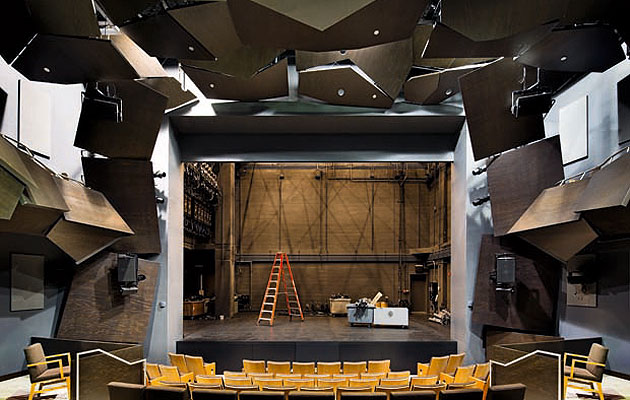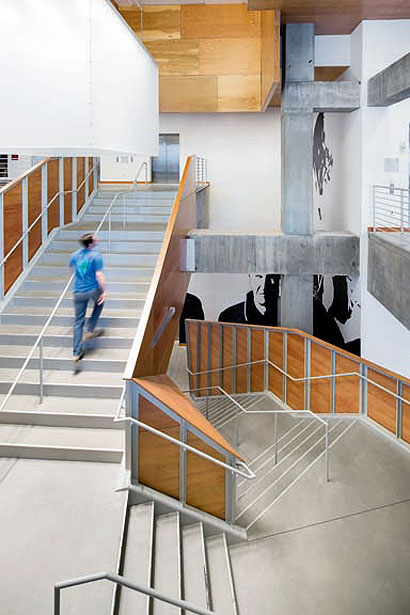|
|
||
|
The Signature Center is the biggest arts complex to be built in New York since the Lincoln Center opened four decades ago. Located on 42nd Street below a nondescript hotel and residential tower, it covers an entire city block just west of Times Square. The centre was originally intended to be housed in a Frank Gehry building at Ground Zero, where three theatres would have been stacked atop one another on a much smaller footprint, but escalating costs returned it to the theatre district, a block away from the Signature’s former home. Gehry agreed to adapt his designs to this new $66 million, 70,000sq ft space. With a tight budget, Gehry has returned to the playful plywood, concrete and glass architecture with which he started his career in Los Angeles. The foyer is filled with a jagged, sculptural, plywood form, which Gehry describes as his “Magritte Apple in the box”, that draws you in from the street. The space houses a wide staircase that curls around and up to an airy 7,500sq ft lobby. James Houghton, who founded the theatre in 1991 with a commitment to putting on new plays at low prices, wanted this lobby, with its unpretentious cafe and bookstore, to be the pulsating heart of the building, a busy space that would facilitate “orchestrated collisions between artists and audiences”. Leading off it are three theatres, as well as a rehearsal space that can be transformed into another if required. The walls of the 299-seat End Stage are animated with sheets of irregularly shaped plywood that overlap each other like roughly applied shards of cracked mud and are coloured in shades varying from natural to black as they approach the darkness of the stage. The boxes and balcony of the Alice Griffin Jewel Box – an intimate 199-seat theatre with a full fly tower that Houghton describes as a “scaled-down European opera house” – are also enlivened with faceted planes of plywood stained a deep brown. The littered set, covered in battered oil cans, corrugated sheets and bare mattresses for Athol Fugard’s play Blood Knot, about a South African slum, complements the architect’s cheerful making-do approach. Indeed, Gehry’s theatres seem to encourage such deconstructive interventions. The Romulus Linney Courtyard Theatre, a flexible space where plays can be shown in the round, also has a sense of artful dishabille. To create the condemned Memphis project in which Katori Hall’s Hurt Village is set, the designer wanted construction to be halted mid-way, but instead has peeled away one wall to create the effect of having bulldozed through into a shabby tenement next door. The corridor that leads to the End Stage is decorated in enlarged versions of Gehry’s sketches, messy line drawings, in which his pen doesn’t seem to leave the page. These bird’s nests of squiggles hint at the dynamism that the architect has succeeded in creating with these intimate spaces, expressive collages that concentrate explosive energy to the stage.
|
Image James Ewing/OTTO
Words Christopher Turner |
|
|
||




















